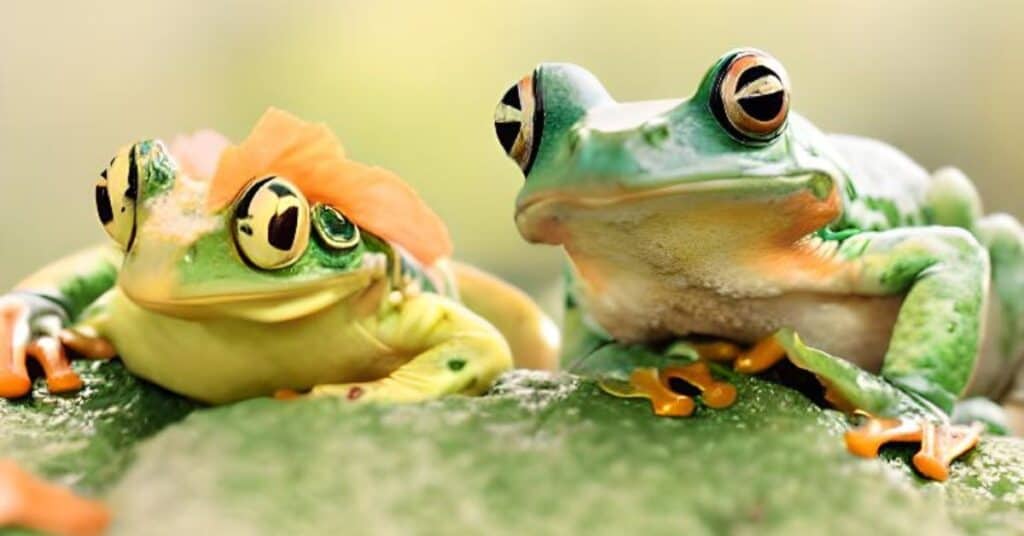This article, “Frogs vs. Toads: What’s the Difference?” compares and contrasts two popular amphibian species, the frog and the toad. Although the terms “frog” and “toad” are sometimes used interchangeably, the two animals are different species with distinct features, behaviors, and habitats.
I used to catch frogs and toads in my backyard when I was little. Before I realized that toads had bumpier skin and shorter legs than frogs, I always assumed they were the same. I began focusing more on their differences and became interested in discovering their unique features.
You will learn these intriguing animals’ biology and ecological significance by exploring the characteristics that set frogs apart from toads. We will also look over the widespread misconceptions about frogs and toads
You can also read about ten weird facts about frogs you need to know here
Let’s get started!
What is the Difference between a Frog and a Toad?
Toads and frogs are both amphibians that are part of the Anura order although they came from different family, while tree frog came from the family of Hylidae, toads came from the family called Bufonidae. Despite having a similar appearance, they can be distinguished from one another by clear differences. Knowing the differences between the two can assist you in identifying them.
Appearance and size of frogs and toads
The size and skin texture of frogs and toads differ noticeably.
Toads have shorter, plumper bodies with rough, dry skin, but frogs typically have longer, slimmer bodies with smooth, wet skin. Toads have shorter legs designed for hopping, but frogs have longer legs meant for jumping.
Frogs are often smaller than toads in terms of size. The Brazilian Psyllophryne didactyla is the tiniest species of frog, with adults measuring 9.8 mm (0.4 inches) or smaller in length. At the same time, the largest can reach lengths of up to 12 inches, such as the Conraua goliath, a species of goliath frog native to West Africa which is the largest frog in the world, has a body length of around 300 mm (12 inches).
On the other hand, the smallest toads can reach lengths of around an inch. In contrast, the largest can reach lengths of up to nine inches, such as the cane toad, which is called giant toad, this is a terrestrial toad native to Central America and South America, the largest toad in the world.
However, you should know that there are exceptions to these generalizations. Some frogs have rough skin, whereas others have relatively smooth skin. Furthermore, the size difference between frogs and toads varies based on the species.
Skin texture and color differences
The texture and color of frogs’ and toads’ skin is another distinguishing feature. Frogs have smoother, moister skin with slimy secretions that keep them moisturized.
On the other hand, toads have rough, dry, and warty skin with a thicker epidermis to defend them from predators.
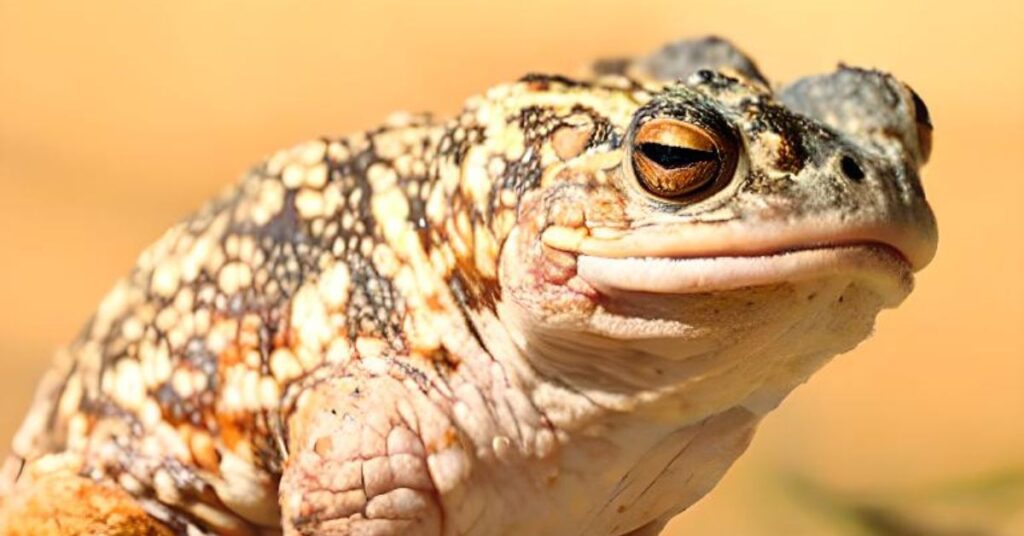
Both frogs and toads can have a wide range of colors, although toads tend to have earthier tones like brown, gray, and olive. On the other hand, frogs can be brightly colored and have patterns that help them blend into their surroundings, warn off predators, or attract mates.
Anatomy differences, such as eyes and legs
Apart from skin texture and color, frogs and toads differ in structure, notably in their eyes and legs.
Frogs have bulging and protruding eyes at the top of their heads, which helps them to see over the water when swimming.
They also have larger rear legs that are designed for jumping and leaping, as well as webbed feet that aid in swimming. On the other hand, toads have more elliptical-shaped eyes that are lower on their head, giving them a larger field of vision for identifying food and predators on the ground.
Toads’ legs are shorter and stouter, intended for walking rather than leaping.
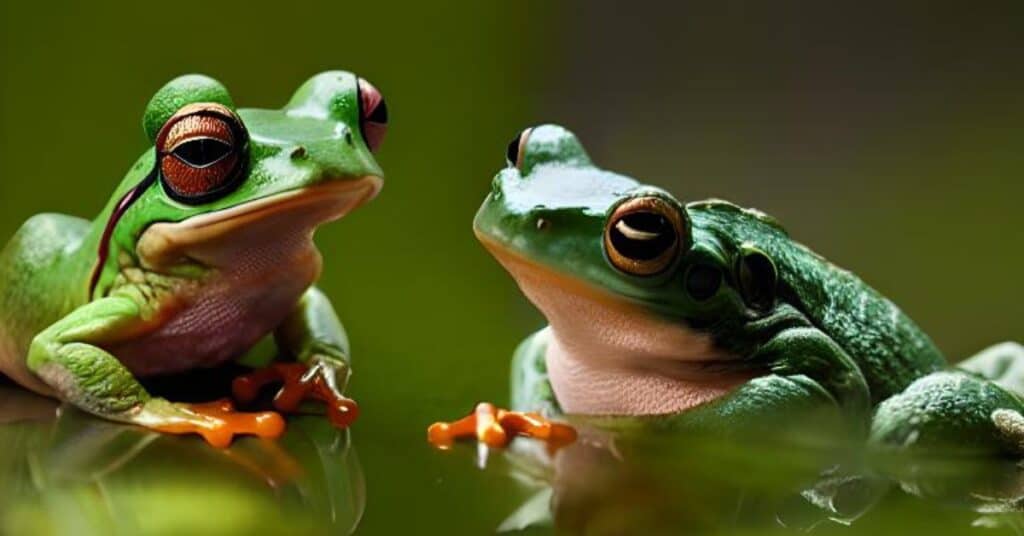
Habitat and Behavior
Preferred habitats of frogs and toads
Frogs and toads have different habitat preferences. Frogs tend to dwell near bodies of water, such as wetlands, marshes, ponds, and streams.
They require a wet environment and deposit their eggs in water to keep their skin moisturized. Conversely, toads may thrive in dry habitats like woods, grasslands, and deserts.
They have adaptations that help them live in harsh environments, including as dry and rough skin and the capacity to burrow underground.
Some toad species, however, still require access to water sources for reproduction. Because of their distinct adaptations and reproductive tactics, frogs and toads have different environmental requirements.
Differences in behavior, such as movement and vocalization
Toads and frogs differ from one another in their behavioral patterns. Some of the behavioral variations include:
- Movement: Frogs are skilled jumpers and swimmers, but toads often have shorter legs and choose walking or crawling over jumping.
- Vocalization: Frogs employ their well-known croaking and singing vocalizations for mating and communication. While toads often make a trilling or whistling sound, they have a more resounding, melodious cry.
- Socialization: While toads prefer to live alone, frogs are more social and like to be in groups.
- Nocturnal behavior: Most frog species are nocturnal, whereas toads are more active during the day.
- Hibernation: While certain frog species may endure the cooler temperatures without hibernating, toads are more inclined to do so throughout the winter.
Diet and Predators
Types of food that frogs and toads eat
Although they both predominantly consume insects and other tiny invertebrates, frogs, and toads have slightly different diets. Some variations include:
- Toads prefer terrestrial insects like ants and beetles, but frogs often consume more aquatic insects like mosquitoes.
- Frogs usually grab food with their mouths, but toads have a unique way of catching it with their sticky tongue.
- While toads usually keep to insects and other invertebrates, several species of frogs are known to devour small vertebrates like fish and other frogs.
You should know that not all frog and toad species eat the same things and that their dietary choices might change depending on their habitat and geographic location.
Differences in hunting and eating habits
Frogs and toads have distinct hunting and feeding behaviors that reflect their anatomical and behavioral differences. Among the significant differences are:
- Hunting technique: Frogs are often avid hunters using their long, sticky tongues to acquire prey. They may dart forward and catch insects and other tiny things with their mouths. Toads, on the other hand, are ambush predators that wait for prey to approach before attacking. They lack the lengthy, sticky tongues of frogs and instead rely on their powerful jaws to catch food.
- Diet: Frogs and toads are carnivorous, eating various insects and small animals. Their diets, however, might vary according to their environment and species. Frogs eat a wider variety of foods than toads, including tiny fish, birds, and other frogs. Toads are more specialized, eating insects and other invertebrates.
- Eating habits: Frogs are noted for their capacity to swallow whole prey, enabled by their flexible jaws and expanding necks. On the other hand, toads have a smaller throat and cannot consume complete prey. Instead, they ground their meal with their teeth before swallowing.
Predators of frogs and toads
Frog and toad predators differ based on the species and location. Snakes, birds, fish, mammals, and other amphibians are common predators of frogs and toads. Humans also endanger frogs and toads through habitat degradation, pollution, and other human-caused activities. These predators serve a vital function in the ecology by limiting the number of frogs and toads, but excessive predation can lead to population decreases and, in some cases, extinction.
Reproduction and Lifecycle
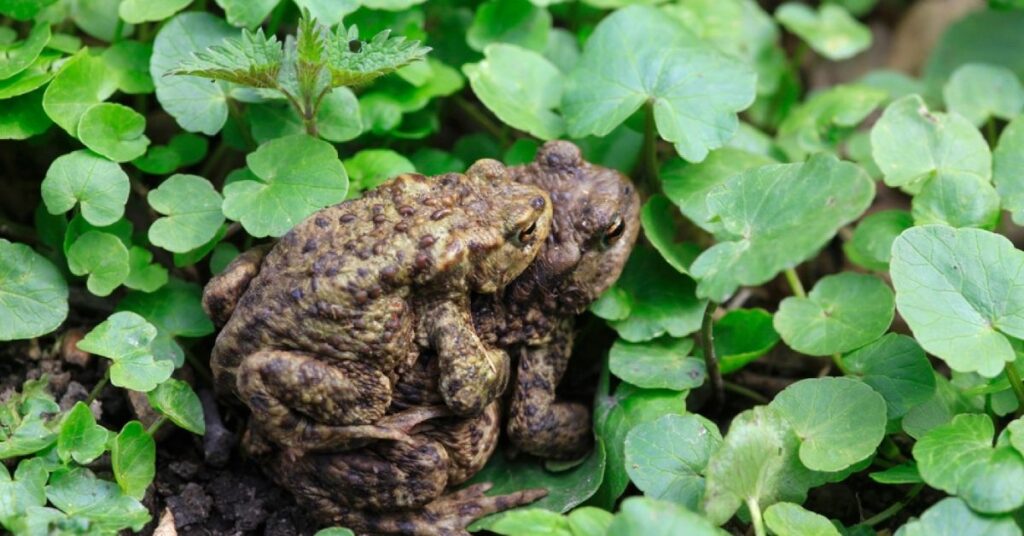
Mating habits of frogs and toads
The different mating behaviors of frogs and toads vary in several ways. Here are some significant differences:
- Mating Season: Toads mate in the late spring and early summer, whereas frogs typically breed in the spring and summer.
- Courtship Behavior: Different courtship behaviors are used by frogs and toads. Frogs often make loud vocalizations to attract females, but toads engage in a more discreet courting activity by making a sequence of motions.
- Amplexus Position: Frogs and toads adopt different postures in the amplexus during mating. Frogs reproduce in the amplexus posture, which involves the male grabbing the female from behind and fertilizing the eggs as they are released. On the other hand, the “axillary amplexus” posture is used by toads, in which the male grabs the female by the forelimbs.
- Egg Laying: Frogs often deposit their eggs in heaps or clusters, but toads typically tie their eggs together.
- Tadpole Development: Frogs and toads develop their tadpoles in different ways. Tadpole frogs grow up rather rapidly, frequently maturing into adult frogs in a matter of weeks. On the other hand, toad tadpoles take longer to develop and can take up to several months to change.
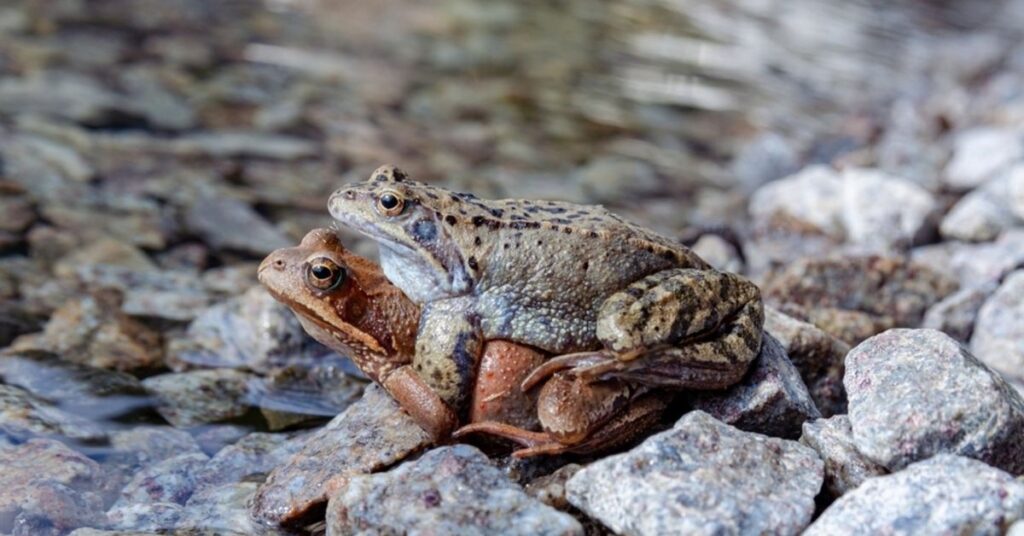
Lifecycle differences
Although they have somewhat similar life cycles, frogs and toads have separate life cycles. Here are some major differences:
Eggs: Toads deposit their eggs in lengthy chains, but frogs often lay their eggs in clusters. Toad eggs have a harder, stringier covering than frog eggs, which are coated in a gel-like material.
Tadpoles: Frog tadpoles primarily eat plants and have long, muscular tails, but toad tadpoles frequently eat both plants and animals. Both species’ tadpoles undergo a metamorphosis process and grow limbs and lungs.
Adults: Adult frogs are recognized for their ability to leap and have smooth, moist skin. Toads often prefer to walk over leaps because of their rough, dry skin. Frogs can jump higher and farther than toads because they have longer hind legs.

Unique Features of Frogs and Toads
| Features unique to frogs: | Features unique to toads: |
| Smooth, moist skin | Warty, dry skin |
| Longer, more slender bodies | Shorter, stockier bodies |
| Long, powerful legs built for leaping and swimming | Shorter legs that are adapted for hopping rather than swimming |
| Webbed feet for better swimming ability | No webbing on their feet |
| Bulging eyes that are positioned higher on the head | Eyes that are positioned lower on the head and are more flattened in shape |
| Typically spend more time in or near water | Tend to live farther from water and in drier habitats |
| Frogs have Maxillary or vomerine teeth located on the upper jaw. | Toads have no teeth |
Common Myths and Misconceptions about Frogs and Toads
All Frogs and Toads are Poisonous
Not all frog and toad species are toxic. However, some do emit poisons that can be dangerous to predators. In actuality, just a tiny portion of the world’s roughly 7,000 amphibian species are thought to be toxic. Most frog and toad species are not harmful to people or other animals.
Frogs and Toads are Slimy and unpleasant to touch
Not all frogs and toads have slimy skin, even though it may feel damp and slippery. In actuality, some species have dry, smooth skin. Their slimy coating results from a protective mucus layer that keeps them hydrated and shields them from predators.
Frogs and Toads Give You Warts
One of the most widespread fallacies about frogs and toads is possibly this one. Contrary to popular belief, you cannot get warts by touching a frog or a toad. Instead of the benign microorganisms that amphibian skin contains, warts are brought on by a virus infecting the skin.
Frogs and Toads Are Noisy and Annoying
Although some frog and toad species can be highly vocal, not all are loud and bothersome. In actuality, several species are virtually silent and utterly silent. Frogs and toads’ vocalization is an essential component of their communication and mating activity, and it should be admired for its distinctive and fascinating characteristics.
Frogs and Toads are Harmful to the Environment
On the other hand, frogs and toads are essential to maintaining a healthy ecology. Due to their sensitivity to environmental changes, they help monitor the health of wetlands and other ecosystems, serving as significant indicators of ecological health. They act as organic pest control agents and aid in reducing insect populations.
CONCLUSION:
After reading about Frogs vs. Toads: What’s the Difference? The next time you see this amphibian, you should be able to tell which is a frog and which is a toad because, despite their apparent similarity, frogs and toads differ greatly from one another.
These two species have unique characteristics that differentiate them from one another, from their outward appearance and habitat to their behaviors and vocalizations.
While it’s simple to think of toads as bumpy frogs, taking the time to learn about these unusual animals can reveal a new level of appreciation and understanding.
We may better appreciate the diversity of the natural world and take action to safeguard these important and fascinating species by being aware of the differences between frogs and toads.
If you find this article interesting, you may wish to subscribe to our news later below for more updates and articles. See also: The 10 Best Pet Frogs for Beginners

